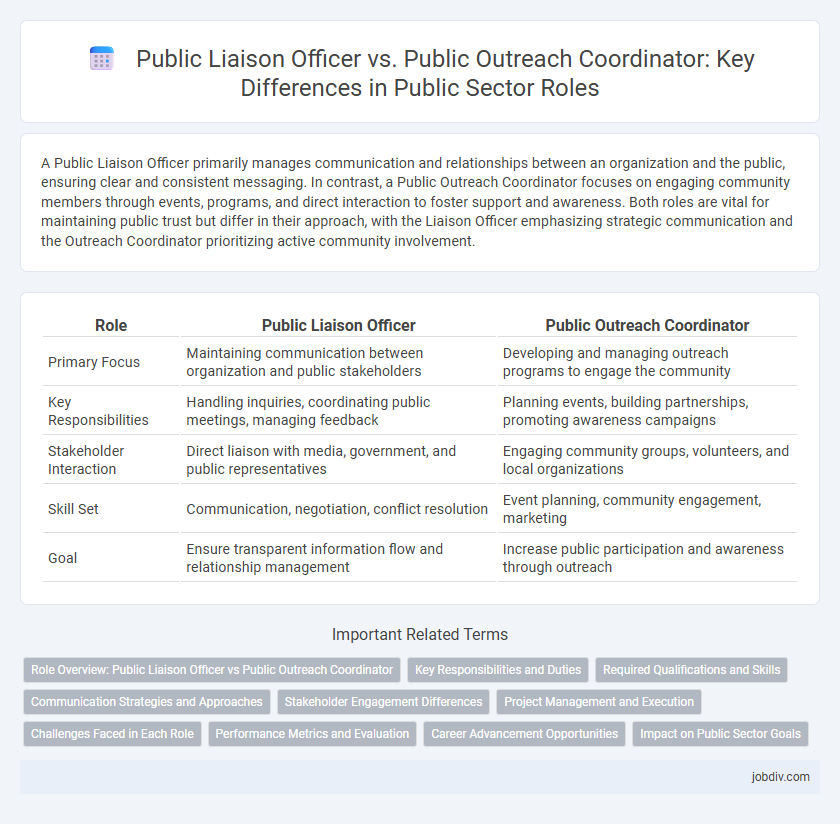A Public Liaison Officer primarily manages communication and relationships between an organization and the public, ensuring clear and consistent messaging. In contrast, a Public Outreach Coordinator focuses on engaging community members through events, programs, and direct interaction to foster support and awareness. Both roles are vital for maintaining public trust but differ in their approach, with the Liaison Officer emphasizing strategic communication and the Outreach Coordinator prioritizing active community involvement.
Table of Comparison
| Role | Public Liaison Officer | Public Outreach Coordinator |
|---|---|---|
| Primary Focus | Maintaining communication between organization and public stakeholders | Developing and managing outreach programs to engage the community |
| Key Responsibilities | Handling inquiries, coordinating public meetings, managing feedback | Planning events, building partnerships, promoting awareness campaigns |
| Stakeholder Interaction | Direct liaison with media, government, and public representatives | Engaging community groups, volunteers, and local organizations |
| Skill Set | Communication, negotiation, conflict resolution | Event planning, community engagement, marketing |
| Goal | Ensure transparent information flow and relationship management | Increase public participation and awareness through outreach |
Role Overview: Public Liaison Officer vs Public Outreach Coordinator
Public Liaison Officers serve as the primary communicators between an organization and its external stakeholders, focusing on managing relationships, addressing concerns, and facilitating clear information flow. Public Outreach Coordinators concentrate on designing and implementing community engagement strategies, organizing events, and promoting public awareness to foster active participation. Both roles prioritize effective communication but differ in scope, with Liaison Officers emphasizing stakeholder interaction and Outreach Coordinators targeting community involvement.
Key Responsibilities and Duties
A Public Liaison Officer manages communication between an organization and its stakeholders, ensuring clear information flow and addressing public concerns to maintain a positive image. A Public Outreach Coordinator focuses on organizing community programs, events, and campaigns to increase public engagement and awareness of organizational goals. Both roles require strategic communication skills, but the Liaison Officer emphasizes relationship management, while the Outreach Coordinator prioritizes community involvement and program execution.
Required Qualifications and Skills
Public Liaison Officers require strong communication skills, experience in government relations or public affairs, and the ability to manage stakeholder relationships effectively. Public Outreach Coordinators need expertise in community engagement, event planning, and social media management, along with proficiency in outreach program development. Both roles demand excellent interpersonal skills, cultural awareness, and the capacity to analyze public feedback for strategic improvements.
Communication Strategies and Approaches
Public Liaison Officers focus on maintaining clear, consistent communication between an organization and its stakeholders, using strategic messaging and targeted engagement to build trust and manage public perception. Public Outreach Coordinators design and implement community-based programs and events to maximize participation and foster direct interaction with diverse audiences. Both roles employ tailored communication strategies, but Liaison Officers prioritize message alignment and media relations, while Outreach Coordinators emphasize grassroots engagement and educational initiatives.
Stakeholder Engagement Differences
A Public Liaison Officer primarily facilitates communication between an organization and its stakeholders to address concerns and maintain positive relationships, emphasizing responsive dialogue and conflict resolution. In contrast, a Public Outreach Coordinator proactively designs and implements programs to engage community groups, raise awareness, and foster long-term stakeholder involvement through education and events. The key difference lies in the Liaison Officer's focus on managing ongoing interactions and feedback, while the Outreach Coordinator aims to expand and deepen stakeholder networks through strategic engagement initiatives.
Project Management and Execution
A Public Liaison Officer typically manages stakeholder relationships and communication strategies to ensure smooth project alignment with public interests, emphasizing negotiation and conflict resolution. In contrast, a Public Outreach Coordinator primarily focuses on planning and executing community engagement initiatives, including event organization and resource distribution to maximize public participation. Both roles require strong project management skills but differ in execution, where the Liaison Officer prioritizes ongoing dialogue management and the Outreach Coordinator drives proactive public interaction campaigns.
Challenges Faced in Each Role
Public Liaison Officers often face challenges in managing diverse stakeholder expectations and navigating complex communication channels to maintain a positive public image. Public Outreach Coordinators encounter difficulties in engaging underserved communities and measuring the impact of outreach programs effectively. Both roles require strategic adaptability to overcome barriers in communication and community engagement.
Performance Metrics and Evaluation
Public Liaison Officers are evaluated based on metrics such as stakeholder engagement frequency, response times, and resolution rates of public inquiries, emphasizing effective communication and relationship management. Public Outreach Coordinators focus on quantitative measures including event attendance, community participation levels, and social media reach to gauge the success of awareness campaigns. Both roles utilize feedback surveys and impact assessments to refine strategies and enhance overall public interaction outcomes.
Career Advancement Opportunities
Public Liaison Officers often advance by gaining expertise in government relations and policy communication, leading to senior roles in public affairs or strategic communication departments. Public Outreach Coordinators typically progress through experience in community engagement and program management, moving into leadership positions within nonprofit organizations or corporate social responsibility teams. Both careers benefit from strong networking skills and continuous professional development to unlock higher-level opportunities.
Impact on Public Sector Goals
Public Liaison Officers facilitate communication between government agencies and the public, directly enhancing transparency and trust, which are critical for achieving public sector goals related to citizen engagement. Public Outreach Coordinators design and implement strategic community programs that increase awareness and participation, driving measurable improvements in public service delivery and social outcomes. Both roles significantly impact public sector objectives by fostering collaboration and ensuring effective dissemination of information.
Public Liaison Officer vs Public Outreach Coordinator Infographic

 jobdiv.com
jobdiv.com